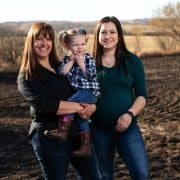Trailblazing
Women farmers reveal how they have succeeded in agriculture, and how other women can too
By Brenda Schoepp, Country Guide
Country Guide asked for more on how we define a culture that is inclusive, equal and conducive for a successful female heir or independent business person from within a family unit.
In this first part of a three-part series, I went across Canada and asked trailblazers — highly successful women in farming, agriculture and agri-business — about their journeys starting from the time they were girls.
They pursued their dreams despite having very diverse back stories. Still, we need to recognize that the on-farm cultures they grew up in were extraordinarily different, and those differences helped determine the pathways they chose to get to where they are today.
The weight of our words
I asked women to reflect on the culture that they grew up in. Those environments that ranged from absolute restriction to complete freedom and operational transparency. The family setting was important, and the activity within it meant that living space could be anything from utter isolation through to a liberal incubator of creativity.
In some farm families the girls were not allowed to explore their potential, let alone work or play outside, while in other families all the children were given free rein to try anything they wished.
In families that looked at the children through the eye of equality, often the girls and boys were given cash, cows, crop or other commodities (including the invaluable commodity of patience) to experiment with, and there was no criticism if things went sideways.
When a family could not afford to do this, there were many instances where a friend or neighbour played a role in getting the children started in business. This built a sense of self-esteem and courage and also introduced the boys and girls to the financial side of agriculture. The more invested the children were without restraint, the quicker they progressed as individuals. These children felt secure.
By contrast, women who were ridiculed, held back, told to lower their expectations or were simply ignored as girls, shared how deeply it cut into their self-esteem and how painful the journey was.
They repeatedly spoke of frustration and grief, and there were remnants of anger for being treated as less of a person. For women with these experiences, it was common to struggle with a lack of confidence, and several reported having been in therapy to deal with grief and to learn how to set boundaries for the future.
Setting personal boundaries
Women who were strongly supported as girls reported it was sometimes a challenge to set boundaries because their spirited capability meant they believed they could do anything. Those who were not supported as girls were focused on setting boundaries so they felt they had control of their choices and felt safe.
The role of the authentic parent
A foundational factor in the rapid success of women in agriculture and business was the authentic parent who modelled what they said and who lived their lives with full investment in the success of their children. The most common word used in the transcripts of this set of interviews was “Dad.”
The way that fathers acted and executed in life had a profound effect on the self-esteem of their daughters.
Dads who fully believed in the capabilities of their children and remained curious in their own lives created a space for confident individualism which is really critical in agriculture. In families without a dad, the mother had the same influence. Most daughters were very forgiving, noting that as long as the families were trying, the women felt they were heard.
Transparent transactions
While being heard was great for confidence, it was never a substitute for authentic action and more specifically for planning. Parents who talked the talk and walked the walk by having specific and transparent insurance, wills, personal directives, business and investment planning, and who shared that consistently with their children, laid the groundwork for successful male and female heirs and independent business persons from the family unit.
Potential conflicts between siblings were deeply mitigated, even in the event of crisis, when transparent planning was in place.
Transparency and truth were the main ingredients in successful family meetings, but the authentic parent took it to the end goal by ensuring they did what they said they would do. When women did not have this experience, they sought and received support from other reliable people in their lives including friends, in-laws, neighbours, mentors, advisors, partners or supportive social groups.
Culture undefined
The process of interviewing brought to light the wide variation in the emotional journey women travelled to become successful in agriculture and related businesses.
Allowing for girls (and boys) to make production and financial decisions early had a deep impact on their confidence and contributed to their own financial independence.
The words and actions of parents, particularly the father, were incredibly impactful. Curious parents and those who were willing to back the child despite their own inexperience were invaluable.
Although these women were all determined and visionaries as little girls, the tools and support systems they employed later in life differed in relation to that early childhood experience. The lack of nurture for some did set them back — for a while — but they found a way to set boundaries, fit in and they nurtured the authentic relationships they needed to progress.
What’s next?
I acknowledge that every family unit is different and families have different levels of access to tools and information. There is no judgment on these pages.
It is inspiring that regardless of the life of the girl, all the women I interviewed found a pathway to success and overcame the obstacles they encountered and are today happy, healthy and significant contributors to our agricultural community.
Their journeys have been both challenging and exhilarating. Read more in Part 2 in the May/June issue of Country Guide.
Source: Country Guide





